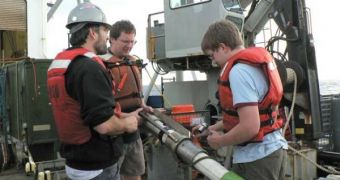The Earth is the only known place in the Universe that is rich and abundant as far as life forms go, and this has become more than clear with recent discoveries. Studies have shown that bacteria, microbes and other basic microorganisms manage to survive in the harshest of conditions, inside volcano craters and near hydrothermal vents, at the bottom of the ocean. But never before has a study been focused on finding the place on the planet where the least amount of creatures lives at one point. University of Rhode Island Oceanographer Steven D'Hondt and his team have found that a patch of ocean in the South Pacific Ocean bears the fewest traces of living cells in its sediment layers.
The researcher took a boat and went in the middle of the Pacific Ocean, drilling core samples from the bottom of the ocean, some 2.5 to 3.7 miles (four to six kilometers) deep. Investigations revealed no more than 1,000 living cells in each square centimeter of deposit, which is about 1,000 times less than in other places on Earth. “People were previously just taking cores in parts of the ocean fairly close to shore and assuming their results were typical of the ocean as a whole,” the researcher shared for LiveScience.
In a paper published in the June 22nd issue of the scientific journal Proceedings of the National Academy of Sciences, the research team hypothesized that the finds they made in the middle of the ocean could apply to other areas off the coasts, in all of the world's oceans. They also said that the readings obtained from drilling near the coast lines might not be representative of the entire stretch of water that covered more than 70 percent of the world's surface. The area D'Hondt studied was located inside a water gyre, an area in which currents ensure that water is still, thus keeping nutrient levels fairly low for organisms to survive.
Apparently, the expert added, the microbes that were detected in the recent drill samples only survived by feeding on the hydrogen atoms that were released in the water when radioactive compounds below the crust broke up water molecules above. With about a half of their good requirements met through this method, the bacteria reoriented the other half of their diet to drifting organic molecules, which fall to the depths from the surface of the ocean.
“If you can support the concentrations we see on a food source that's basically half hydrogen from the radioactive splitting of water, then maybe you can support a few hundred cells in wet sediments on Mars or Europa. It suggests that life is resilient enough under very low access to food,” the researcher concluded, talking about the possibility of applying these finds to methods of detecting or implanting life on other planets.

 14 DAY TRIAL //
14 DAY TRIAL //